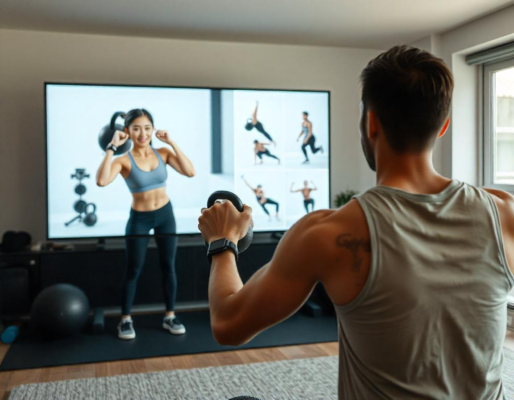
In the era of rapidly evolving technology, artificial intelligence (AI) is changing the game in every industry, including health and fitness. With AI-powered apps, virtual coaches, and personalized fitness plans gaining traction, the question arises: can AI replace your fitness trainer? Let’s dive deep into this debate and uncover the potential, limitations, and future of AI in fitness.
For virtual assistance or want to make a product for fitness geeks contact professionals dev’s
The Rise of AI in Fitness: A Game-Changer or a Gimmick?
The fitness industry has embraced AI like never before. AI tools analyze data, track progress, and design custom workout routines tailored to individual goals. From apps like Freeletics and MyFitnessPal to AI-powered wearables like Fitbit, the integration of machine learning has redefined how we approach fitness. But can these tools replace the human touch of a fitness trainer?
What Makes a Fitness Trainer Special?
A human fitness trainer brings more than just expertise in exercise routines. They provide:
- Emotional Support: Trainers motivate you during tough workouts.
- Personalized Adjustments: They adapt plans based on your physical condition or preferences.
- Accountability: Trainers ensure you stick to your routine.
Now, let’s see how AI stacks up against these human qualities.
How AI Personalizes Fitness Plans
One of the biggest strengths of AI lies in its ability to analyze data. AI-powered fitness apps use your workout history, physical stats, and health goals to create a custom fitness routine. Here’s how AI works its magic:
- Data Analysis: Apps collect data from wearables, tracking your steps, calories burned, and heart rate.
- Progress Tracking: AI evaluates your performance and adjusts your plan accordingly.
- Injury Prevention: By analyzing movement patterns, AI detects risks and suggests corrective measures.
For instance, AI-driven apps like Vi Trainer simulate the role of a coach, guiding you through exercises with voice commands. Yet, these solutions lack a personal connection, often crucial for sustained motivation.
Can AI Understand Emotional and Physical Nuances?
A human fitness trainer observes your posture, energy levels, and mood, tailoring exercises on the spot. On the contrary, AI operates solely on data inputs, making it less adept at responding to the subtleties of human emotions. For example:
- A human trainer might notice signs of fatigue and recommend a lighter session.
- AI may fail to detect these nuances unless explicitly programmed.
While advancements like emotion-tracking wearables are emerging, they’re not yet a replacement for human intuition.
The Benefits of AI in Fitness Training
Despite its limitations, AI offers numerous advantages, such as:
- 24/7 Accessibility: AI apps are available anytime, making them ideal for busy schedules.
- Cost-Effectiveness: Subscriptions to AI apps are often cheaper than hiring a personal trainer.
- Scalability: AI can serve millions simultaneously, unlike human trainers with limited time.
These features make AI an appealing option for fitness enthusiasts, particularly beginners who want to kickstart their journey.
The Limitations of AI Fitness Trainers
So, can AI replace your fitness trainer entirely? Not yet. Here’s why:
- Lack of Human Interaction: Motivation often comes from a personal connection, which AI cannot replicate.
- Inflexibility: AI struggles with on-the-fly changes based on unexpected circumstances, like injuries.
- Generic Advice: While AI personalizes plans, its understanding of complex human needs is limited.
For intermediate to advanced athletes, AI often falls short in delivering the expertise and adaptability of a seasoned trainer.
Blending AI with Human Trainers: The Hybrid Model
The future might not be a choice between AI and human trainers but a combination of both. Hybrid fitness models offer:
- AI for Data-Driven Insights: Tracking progress, monitoring form, and creating plans.
- Human Trainers for Emotional Connection: Offering encouragement and adjusting strategies in real-time.
This synergy ensures you get the best of both worlds, enhancing your fitness journey.
Key Factors to Consider Before Choosing AI Over a Human Trainer
When deciding whether to rely on AI or stick with a human trainer, consider:
- Your Fitness Goals: AI suits basic weight loss or fitness tracking, while human trainers excel in specialized training.
- Budget Constraints: AI is a cost-effective solution for those unable to afford regular sessions with a personal trainer.
- Preference for Human Interaction: If accountability and motivation matter to you, a human trainer might be indispensable.
The Future of AI in Fitness
As AI technology advances, it’s poised to bridge the gap between data-driven precision and human-like empathy. Innovations like AI avatars, emotion-detecting sensors, and virtual reality training environments hint at a future where AI becomes more “human.” However, whether it can fully replace your fitness trainer remains uncertain.
Final Verdict: Can AI Replace Your Fitness Trainer?

While AI offers convenience, accessibility, and innovation, it lacks the personal connection, intuition, and adaptability that human trainers bring. For now, AI complements human trainers rather than replacing them. The hybrid model, where both work in tandem, seems to be the ideal approach for a balanced fitness journey.
FAQs
- Is AI suitable for beginners in fitness?
- Yes, AI fitness apps are excellent for beginners as they offer cost-effective and accessible workout plans.
- What are the best AI fitness apps available?
- Popular options include Freeletics, Vi Trainer, and MyFitnessPal.
- Can AI help with injury prevention?
- To some extent, AI can analyze movement patterns and suggest corrections, but it lacks the depth of human expertise.
- Will AI ever fully replace human trainers?
- Unlikely. While AI will advance, it cannot replicate human intuition and emotional support.
- What’s the best way to integrate AI into a fitness routine?
- Use AI for tracking and data analysis while relying on a human trainer for motivation and complex adjustments.
